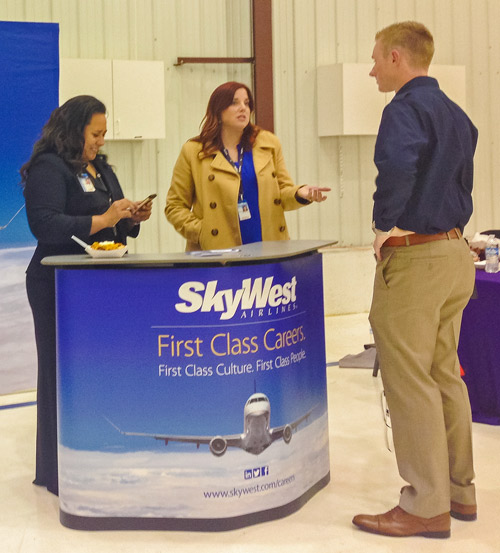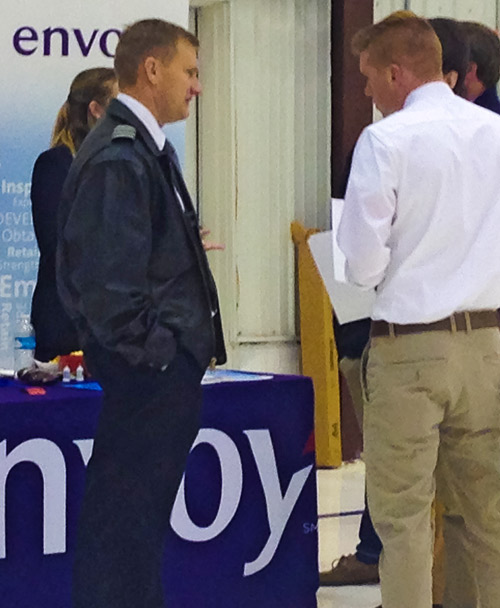Pilots Wanted! Shortage creates huge demand for USU aviation grads
December 8th, 2015 Posted in OpinionStory & Photos by Amanda Wray
LOGAN — A national pilot shortage is forcing regional airlines into new territory: pilot recruiting.
“For the first time ever, some of these airlines are unable to fill their ground schools,” said Aaron Dyches, chief flight instructor of Utah State University’s professional pilot program. “Now, instead of having a million pilots waiting on them, they’re stepping out of their comfort zone and looking for pilots.”

BOARDING PASS — Eight airlines came to USU recently looking for pilots. (Amanda Wray photo)
In the last decade, the United States has seen a steady decrease in the number of pilots from 522,112 in 2005 to 467,576 in 2014, according to the Federal Aviation Administration (FAA). But demand for pilots is increasing.
Over the next 20 years, the Boeing Co. alone expects the United States to need 95,000 more pilots.
In 2008, the aviation industry took a huge hit. Fuel prices skyrocketed. Travelers couldn’t afford to travel. Interest in becoming a pilot plummeted due to the hefty price tag for training and licensing, and the industry lost a lot of personnel and money, the International Air Transport Association reports. Congress passed a bill raising the pilot retirement age from 60 to 65, which meant fewer spots for young pilots hoping to advance to the airlines.
Now, those extensions are running out – the Air Line Pilots Association anticipates 21,000 pilots will retire in the next decade – leaving regional airlines scrambling to fill their ground schools and the holes left by pilots jumping to the major airlines.
Representatives of eight regional carriers — Envoy, Horizon, SkyWest, Endeavor, Republic, Trans States Airlines, GoJet and Mesa Air — attended USU’s first-ever aviation career fair in November.
Dyches sees the fair as a evidence of the regional carriers’ demand for pilots.

SkyWest recruiters talk to a prospective pilot trainee at USU’s first-ever aviation fair. (Amanda Wrap photo)
“Normally, a fair like this would be held at LAX (Los Angeles Airport), where you pay $125 just to meet with these airlines,” he said. “I know, because I did that, and now I’m getting them to come out to this far-flung corner of Utah.”
Envoy recruiter and Embraer 145 First Officer Jessica Hines agrees.
“When I was looking for a job in 2008, the airlines didn’t come to Utah State to try to recruit pilots, and universities didn’t have career fairs,” Hines said. “The industry is changing more into the airlines trying to get the pilots versus pilots trying to get the job.”
Some regional airlines are offering retention bonuses, signing bonuses, guaranteed line pay —meaning pilots are still paid if their flights are grounded due to weather or other hazards — and other salary incentives to attract pilots.
Three regional airlines have approached Dyches and asked for 100 pilots each year, but only 50 to 60 pilots are graduating from USU each semester.
“I told them no,” Dyches said. “Where I’m at right now I’m unable to do that. That takes a whole culture shift, and how can I attract students?”
The cost of an aviation degree is enormous. At USU, aviation students pay $62,093 in flight fees on top of tuition, which means an in-state student must invest nearly $90,000 to earn an average starting salary of $22,400 in their first year as a first officer at a regional airline, according to the Air Line Pilots Association’s 2014 report. Dyches believes if airlines offered options for students to fund their education in the beginning, more students would be interested in becoming pilots.
But the career is only getting more expensive as expectations on pilots increase.
In 2009, Colgan Air Flight 3407 crashed near Buffalo, New York, after a pilot error, killing everyone on board. Citizens and lawmakers demanded more qualified pilots. The FAA responded two years ago by requiring pilots to obtain an Airline Transport Pilot License, which requires 1,500 flight hours, before commercial airlines can hire them.

Envoy is one of eight airlines clamoring for new pilots from USU’s aviation program. (Amanda Wray photo)
When Dyches interviewed for a commercial airline job in 2003, he needed only 1,200 hours of flight experience. The new ATP requirement adds an additional 300 flight hours and $10,000 for ground and simulator instruction, and airlines are only just starting to pay the license fees for new hires, he said.
The U.S. General Accountability Office reported that fewer students are entering and completing collegiate pilot training programs every year, but USU’s aviation program has been steadily growing. Today, the program has 200 active students, and program administrators are working with airlines to create incentives to attract more students.
Three years ago, USU instituted the SkyWest Cadet Program, which allows students to travel to Salt Lake City to train and work with the airline before getting hired.
USU also started a pipeline program with Envoy. Students can get hired on as an Envoy employee while still completing their hours as certified flight instructors (CFIs). These employees get travel privileges, full benefits and start retirement funds.
“It’s a bridge program for students to come from graduation to getting the ATP minimums to come to a regional carrier, so we can employ them during that time,” said Hines, the Envoy rep at USU’s aviation fair. “We give them travel privileges and all the benefits I get as a pilot, and once they get their time, they go straight to a class.”
USU aviation technology senior Kiano Stoppani, 20, from Port Angeles, Washington, had his final interview with Envoy in Dallas in August and signed a contract later that month.
“I liked what they were offering for instructors,” Stoppani said. “You’re getting the same benefits that American Airline employees are getting. It makes you feel like you are actually part of the airline already.”
While in Dallas, USU hired Stoppani as a CFI. It was a “big moment” for his career, he said.
Now he has a straight path to American Airlines and won’t need another interview, since Envoy feeds the airline, Hines says. Stoppani called this his “safety net,” and another reason he chose this program. Plus, there’s cash.
“We have an agreement with Utah State where we can get students a $10,000 bonus the first day of first officer training with a two-year agreement,” Hines said. “They get a nice big check that first day of class.”
Stoppani has about 400 flight hours logged, and is building the required hours to start training at Envoy while instructing. As an Envoy employee, he doesn’t have to worry about the Affordable Care Act while he instructs. Dyches currently hires CFIs as university employees at 29.5 hours per week, but since he contracts out for Envoy employees, Stoppani can fly as many hours as he wants.
“The opportunities that I’ve been given here as far as the airlines are much more than I thought I would have,” Stoppani said. “It’s nice to know that I have a path lined out for me, and that I’m set in the direction that I want to go.”
In the last three years, USU’s aviation program has had 100 percent placement for graduates, though some have gone to drive trains, fly drones or do survey work. Eighty percent of these students, who aren’t part of the military, go on to SkyWest Airlines, but Dyches thinks that percentage might change as Envoy and other airlines begin investing in students.
He thinks the placement rate will continue, as the demand for pilots at regional airlines increases and USU’s program improves.
“The level of professionalism we’re producing makes those airlines want our students,” he said. “We want them to succeed.”
TP
Tags: Aaron Dyches, airlines, Envoy Airlines, pilot shortage, pilots, SkyWest Airlines

Sorry, comments for this entry are closed at this time.